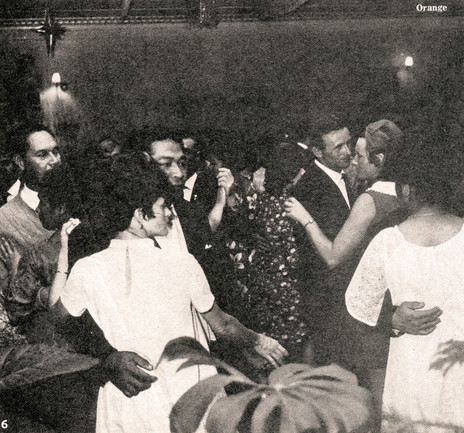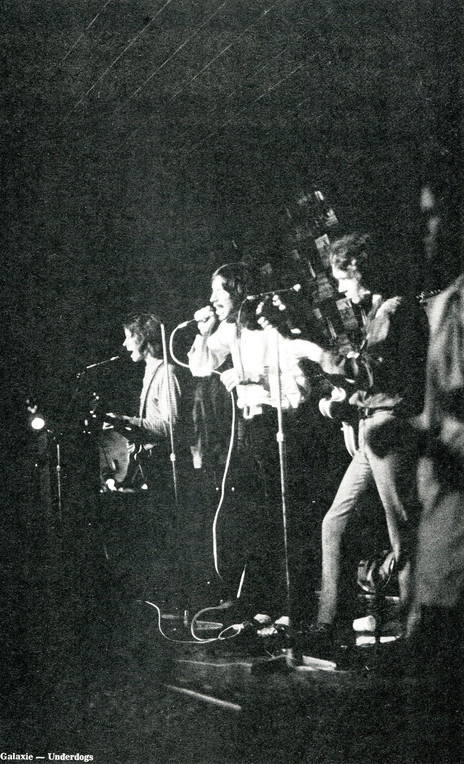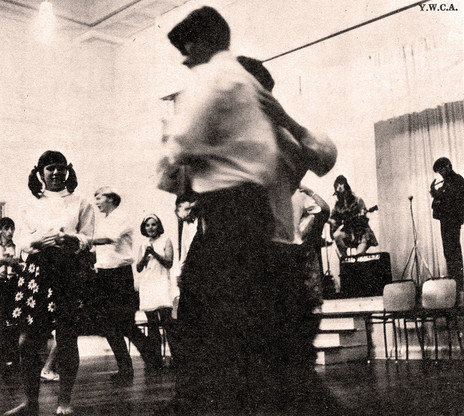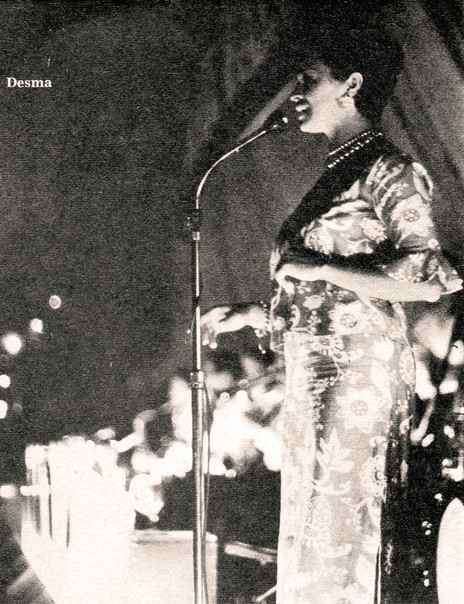Country to cabaret, oldtime to pop: in April 1969 Playdate reported on five Auckland dance venues, and found five contrasting scenes. Photos by Max Thomson.
Orange Ballroom, Newton Road
The sound bounces out of the hall onto Newton Road: robust and exciting, an invitation to enter. A successful invitation. The hall is crowded, knots of people at the door, and inside, under a ceiling resplendent with flashing lights, stars, a revolving reflective globe and decorative fringes, the dancers are almost elbow to elbow. Bill Sevesi’s band has been resident at the Orange for 16 years – quite a record, and the crowd testifies to their continuing popularity.

Orange Ballroom, Auckland 1969.
Many of the dancers are Polynesian, and though many more of the men wear conservative suits, some are in floral shirts to rival the splendour of the ladies’ dresses. These are as bright as record covers, as varied as flowers, and in their jostling motion the dancers shift like kaleidoscope images. But simply to watch is to ignore the urging of the music. It is music to move to. This is pop lifted out of the context of this week’s Top 20. It has all the immediacy, the simple, direct and brash vitality that signalled the birth of pop in the 1950s. And in some ways the Orange recalls the past, e.g. the Twist is featured. In repertoire there is a leaning towards country and western – the lamenting side of pop (‘Everybody Sees The Tears I Cry’, sings Freddie Keil) but even through such material comes a Polynesian flavour, that other moon-watching sadness (the moon over the Pacific not over the range) evoked by the distinctive, haunting sound of Hawaiian guitar. When the band leaves pop, the drummer crouching to play a percussion instrument, drumsticks beating on wood, the excitement is basic and undeniable.
There is a firm regional quality about the Orange – this is very much an Auckland dance, whether the music is originally from the States or the islands. There is Auckland’s colour and excitement here, a Saturday night out which is very urban (perhaps it is the Newton Road area), the people Aucklanders, and the atmosphere relaxed but energetic – not big-city push nor small-town community but Auckland’s own meeting-place atmosphere, quite exhilarating.
The Galaxie, Customs Street
Surfacing head-first like a swimmer, you enter the Galaxie from stairs that open into the middle of the hall. So first impressions come at floor level. The Underdogs are playing Lennon-McCartney’s ‘Baby You’re A Rich Man’. Murray Grindlay, expressionist, working the vocal. Less arresting, guitarists Harvey Mann and Chas Burke-Kennedy, the ever-ebullient Doug Thomas drumming. The excitement of today’s idiom.

The Underdogs at the Galaxie, Auckland 1969.
Try to ignore the music long enough to gather second impressions. The lighting is minimal and the ceiling black above those strings; in such low-key lighting, visibility is not great. The dancers are with the Dogs. The dancers are young, of course. The scene is all “of course”. A pop dance with a top group playing to the kids and pop fans, their dress happy in echoes of pirates, Red Indians, gypsies – all the “free” people, their dancing free too, like free fall. This is today, no tomorrow. A good scene, with reservations about a prolonged laughing fit from someone at a record player; he jokes with the Underdogs (joking I guess for he doesn’t stop laughing anytime), so I guess again that he must be all right. The Underdogs are now at Harrison’s ‘While My Guitar Gently Weeps’. I like that.
YWCA, Queen Street
Pause at the top of the stairs. To the right, people and the sound of a guitar. The hall lights are bright, the walls light. A clean, well-lit place. At one end a stage, and on stage, Thelma Blyth, and the guitar heard from the foyer.
Blyth is the focus of everyone’s attention, and belatedly, your mind makes a connection: the origin of “calls the tune.” The square-dance caller in complete command of the situation. Thelma Blyth is all assurance and enthusiasm. Here she is in a triple role: musician, caller and teacher. Teacher because this is early in the season, and square dances, involving groups instead of couples, demand some knowledge of steps and patterns. This knowledge is gained in preliminary walkthroughs to spoken instructions. But square-dance calling is instruction in itself, and soon the dancers are whirling to the country music, stepping it out with growing confidence as the familiar and joyful call rises above the guitars like some inspired race commentary.

Dancers at the YWCA, Auckland 1969.
The dancers are eager pupils. Some are still young enough to be at school, others must be old enough to have grown children. This is truly a family affair. The YWCA is a far cry from the frontier. This lofty ceiling and huge wall mirror, fresh cream walls and red stage curtains, polished floor and padded sofas are not “country.” Even the paintings of early New Zealand are but a faint reminder of distant days when pioneers united in a struggle to tame a new land.
But there is community here. You see it when someone loses track, blunders the wrong way. The smiles are friendly, the group offers ready advice, and the erring couple scamper on to re-join the dance. Crew cuts and balding heads, short-back-and-sides young and old, girls and matrons – “everybody swing.” Square dancing is togetherness. The setting would not do for The Country Touch and even the costumes are not picturesque enough: dress is free and easy, a man in shorts, one girl in slacks, not many ties. Pastel shirts or white, open at the neck, no jeans: dress is informal but nothing that isn’t clean and neat. Like the girls’ hair: natural, bows, headbands or loose but not prettified. The older women look like mothers, dependable, happy, settled people. Security here in this hall. And joy too: chorus singing is near irresistible. The dancers join in for ‘Swanee River’. And clapping. The music has charms. And everybody claps, clap, clap, clap as one couple from each group crosses the square. The music – the policy is a 50/50 mixture of traditional and modern square-dance music from the US – is jolly music. And this is a jolly dance. Good, clean fun: the phrase is trite, a joke, but here is the actuality.
Municipal Hall, Broadway
‘Softly, as in a Morning Sunrise’ is your entry into the Municipal Hall, Broadway, Newmarket. Very softly. The violin weaving fragile patterns of nostalgia, and you a visitor from an outside world, enchanted but unsure, like a child at a party where he knows no one. Also party-like: the decorations strung between the lights, and down the sides of the hall wall-lights in primary colours, and the ladies in their “party dresses”. It is a festive scene, but like Christmas, tinged with memories and the sadness inseparable from memories. The festivity is expressed formally. I am reminded of a friend’s comparison of Sundays in the Netherlands and in New Zealand. In Europe everyone dressing in their best “Sunday” clothes; in New Zealand contrasting Sunday freedom in the familiarity and comfort of one’s oldest clothes.
For this “Old Time Dance of Distinction” the ladies do not wear formal evening gowns, but they are dressed finely, their frocks supplemented, in almost every case, with jewellery – strings of pearls, lockets or brooches. And their hair, grey hair, white hair, is permed. The men make concessions to the warmth of the evening – almost all are in shirt sleeves, white shirts of course, and almost all wear dark grey trousers, dark ties … and tiepins. But there are exceptions – some wear bow ties, and one gentleman wears a striped shirt, blue trousers and brown shoes.
The chairs are comfortably padded, many are draped with cardigans, “reserved” with handbags or purses.
The floor is crowded. There is a surprise here in both music and dancing. This is “old time” music and many of the dancers must be grandparents, but there is strange energy in both. The songs (many dancers sing along, the lyrics surely engraved on their memories) are the “old songs” which even I remember from countless Sunday request sessions on radio. These are the “old favourites” – sweet, sentimental, but played by the musicians with an almost muscular energy – violin dominant, but piano and drums worthy in support. And the dancers, their faces far from expressive, their movements slowed by age, are somehow undaunted. I see their faces as testaments to life, and I wonder at the vastness of their experience – how much these people must have seen. Their present enjoyment is real and in a sense I find I share it just by being here, but I suspect that the dancers are also enjoying the past, savouring memories evoked by this, their music.
‘Sunrise’ ends and the dancers withdraw to seats at the sides of the hall. The chairs are comfortably padded. Many are draped with cardigans, “reserved” with handbags or purses. One of the musicians removes a card from a stand at one side of the stage. The cards give the names of the dances in order of performance. The list reads: Monte Carlo, Maxina, Veleta Polonaise, Gipsy Tap and Fascination Waltz.
In addition there is a raffle. Numbers are drawn from a hat, the MC jesting about the youthfulness of the smaller numbers and the winners crossing the expanse of empty dance floor, like batsmen walking from pavilion to batting crease. Prizes are wrapped, mysterious, except for those given away by their shape. “Don’t drink it on the premises,” quips the MC, one of the two managers. He is an able MC, has good rapport with the dancers, and is brief. He reintroduces the orchestra. The music resumes. The violinist displays versatility, playing trombone and vibes. The old songs are phoenixes. The dancers also rise again and nostalgia reigns.
The Palladium, K Road
Remembering the Tivoli theatre, it seems strange to enter the same foyer to visit the Palladium, Karangahape Road. Spare a brief thought for childhood expeditions to so many cinemas now converted. In Karangahape Road alone: the Tivoli, Playhouse, Vogue and Avon. Not one left!

Desma singing with Arthur Skelton's band at the Palladium. Auckland 1969.
Snap out of nostalgia – this is no old-time dance. Arthur Skelton’s suave, strict tempo sound is balm for a mind grown conscious of its age – not yet 30 and I am lamenting the inroads of time! The sophisticated decor of the Palladium is a mild surprise. The sweep of the circle divides the downstairs area into lounge (back stalls area) and dance floor (front). The lounge is carpeted in red, the lighting dim and rosy. Chairs and tables are not too close, for the lounge meets the dance floor on three sides and there is ample room. On the fourth side the stage and band, quite a big band too – a substantial frontline of brass – four saxes. Vocalist Desma caresses yesterday’s ‘Volare’. The atmosphere is “romantic” – soft lights and sweet music. There are palms, also Christmassy decorations: fir tree and paper bell. A huge sign, “The Palladium,” in-gold letters on a banner spanning the curtains behind the band.
The couples glide across the floor. Dancing for romantics – you can stay close to your partner all evening, need no-one else. Atmosphere of Sinatra albums for swinging lovers: romantic sentiments and bright, smooth sound. The dancers – swinging sophisticates – office workers, those in business. All with an air of careful grooming. The ladies, surely readers of magazine articles on how to look your best, buyers of cosmetics. The men in dark suits, most retaining their coats, formal bow ties, neatly parted hair. Everything one removed from Bond – a night out with style. And the tasteful sounds of Arthur Skelton’s band – ‘Lara’s Theme’ ...
--
Read more: Auckland, 1969: The Late Shows
Link: Mapping Auckland Venues, 1960s
--
After five years as the assistant editor of Playdate, in 1972 Tom McWilliams joined the NZ Listener, where he had a long career as executive chief sub-editor and occasional film critic.